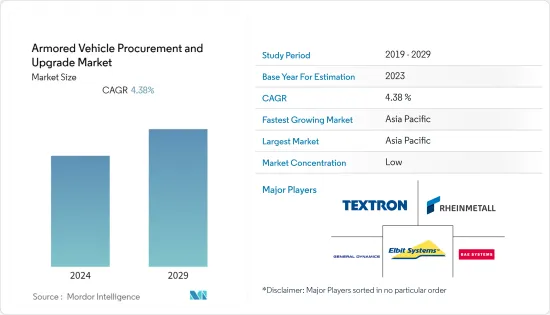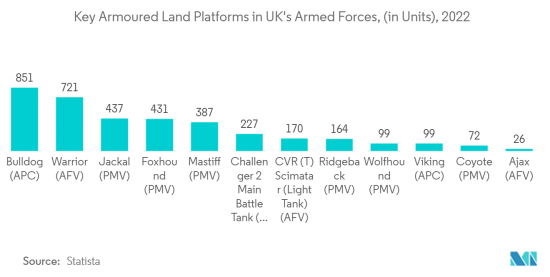
장갑차 조달·업그레이드 시장은 2024년에 66억 6,000만 달러로 평가되며, 2029년에는 82억 6,000만 달러에 달할 것으로 예측되며, 예측 기간 중 CAGR로 4.38%의 성장이 전망됩니다.

국가 및 지역 안보에 대한 요구가 점점 더 높아짐에 따라 인도, 영국, 프랑스, 미국과 같은 국가들이 조사 대상 시장의 주요 중심 국가가 될 것으로 예상됩니다. 이들 국가의 군비 증가는 군가 증가하는 수요를 충족시키기 위해 이러한 차량을 조달하는 데 막대한 비용을 지출 할 수있는 자유를 부여하여 이러한 측면에서 도움이 될 것으로 예상됩니다.
광활한 육상 국경을 가진 국가들은 장갑차의 유리한 시장으로 부상하고 있습니다. 특히 아시아태평양과 유럽에서 육상 차량 조달이 증가하고 있습니다. 그 배경에는 이웃 국가들 간의 정치적 긴장이 고조되고 이 지역에서 적대적인 활동이 증가하고 있기 때문입니다. 또한 이러한 요인으로 인해 육상 차량에 최신 기술을 적용해야 할 필요성이 증가하고 있습니다. 이는 업그레이드 및 개조 활동의 주요 원동력이 되고 있습니다.
기존 장갑차의 업그레이드 수요는 무기 시스템, 통신 및 기타 차량 보호 및 무기고 관련 신소재의 개발로 인해 유발됩니다. 장갑 업그레이드 및 개조 분야에서 시장 기회가 창출될 것으로 예상됩니다.
IFV에 대한 수요는 최근 전 세계 군에서 높은 화력을 가진 차량에 대한 요구로 인해 IFV에 대한 수요가 증가하고 있으며, IFV는 MBT보다 저렴하고 정비가 용이합니다. 또한 IFV는 MBT보다 높은 기동성을 포함하도록 설계되었습니다. 또한 IFV는 APC와 같은 인원 보호가 가능하고 사격 능력이 뛰어나 APC를 대체하는 데 사용되고 있습니다. 이러한 인기 상승에 힘입어 최근 IFV의 조달과 업그레이드가 증가하고 있습니다. 예를 들어 영국 육군은 AJAX(기갑 기병) 및 복서(기계화 보병) 차량으로 장갑차 현대화를 추진하고 있으며, 나스미스 그룹(Nasmyth Group Limited)은 복서 프로그램에 정밀 가공 및 제조 부품을 제공하는 계약을 체결했습니다. 에이잭스는 완전히 디지털화된 첨단 육상 차량으로 영국 육군의 미래형 장갑차를 혁신적으로 변화시킬 것입니다. 에이잭스 차량 시스템은 향상된 살상력, 기동성, 생존성, 전천후 지능, 감시, 표적 포착 및 인식 능력을 제공하며, 2022년 에이잭스 차량은 소음 및 진동 테스트를 거쳐 2023년 첫 번째 차량이 인도될 예정입니다.

지역별로는 아시아태평양이 2023년 가장 높은 시장 점유율을 차지했습니다. 이 지역은 또한 중국, 인도와 같은 국가 수요 증가에 힘입어 예측 기간 중 가장 높은 CAGR을 기록할 것으로 예상됩니다. 중국의 생산 능력은 장갑차, 돌격 차량, 포병 시스템 및 포탄, 방공 포병 시스템, 주전차 및 경전차 등 거의 모든 지상 시스템 범주에서 발전하고 있습니다. 중국북방산업집단공사(Norinco)는 최근 수년간 국산 장갑차의 생산과 판매를 늘리는 데 주력하고 있습니다. 이러한 차량은 수명을 연장하기 위해 업데이트가 필요합니다. 따라서 중국에서는 개조 및 현대화 시장이 크게 성장할 것으로 예상됩니다. 또한 인도도 국경 국가들과의 문제로 인해 장갑차 전력을 강화하고 있습니다. 노후화된 장갑차의 현대화가 주요 관심사입니다. 예를 들어 마힌드라 디펜스 시스템즈(MDS)는 2021년 3월 인도 국방부(MoD)로부터 1억 2,740만 달러 규모의 계약을 체결하고 인도 육군에 장갑전술차량(LSV) 1,300대를 납품했습니다. 마힌드라의 장갑전술차량은 기관총, 자동유탄발사기, 대전차 유도미사일을 운반하는 수단으로 활용됩니다.
또한 2021년 12월 호주는 한화디펜스에 호주 육군에 자주포 30문, 장갑차 15대, 군용차량 15대를 납품하는 10억 달러 규모의 계약을 발주했습니다. 또한 2023년 7월 호주 육군은 한화디펜스에 60억 달러 규모의 계약을 발주하면서 라인메탈의 경쟁사인 링스 보병전투차보다 한화 '레드백' IFV를 선택했습니다. 이러한 계획은 향후 수년간 아시아태평양 시장 전체에 대한 전망을 높일 것으로 예상됩니다.
장갑차 조달 및 업그레이드 시장은 단편화되어 있으며, 많은 세계 및 현지 업체들이 제조, MRO 및 업그레이드 역량으로 경쟁하고 있습니다. General Dynamics Corporation, BAE Systems plc, Rheinmetall AG, Textron Inc., Elbit Systems Ltd. 등이 이 시장의 유명 기업입니다. 이 시장에서는 지난 10년간 현지 기업의 수가 증가했습니다. 아시아태평양, 중동 및 아프리카에서 장갑차의 노후화가 진행되면서 이 지역의 현지 업체들이 역량을 개발하는 데 필요한 기회를 제공하고 현지 시장에서 큰 점유율을 확보하는 데 도움이 되었습니다. 각국은 현재 자체 3세대 및 4세대 MBT 및 기타 장갑차를 현지에서 생산할 수 있습니다. 이러한 경쟁 환경에서 세계 업체들은 더 높은 매출을 누리고 있는 미국과 유럽연합(EU)을 제외한 주요 기업으로 남아 있으므로 정책 및 납품 약속을 개선해야 합니다. 또한 향후 수년간 세계 업체들이 현지 제조업체와 경쟁하기 위해 가격을 낮출 가능성도 있습니다.

The Armored Vehicle Procurement and Upgrade Market is valued at USD 6.66 billion in 2024 and is expected to reach USD 8.26 billion by 2029, registering a CAGR of 4.38% during the forecast period.
With the ever-increasing need for national and regional security, countries such as India, the United Kingdom, France, and the United States are anticipated to be the primary centers in the market studied. Growing military expenditure of these countries is expected to help in this regard by giving freedom to the militaries to spend huge amounts for the procurement of these vehicles in order to satisfy the increasing demand.
Countries with vast land-based borders are emerging as lucrative markets for armored vehicles. The procurement of land-based vehicles is increasing, particularly in Asia-Pacific and Europe. It is due to the growing political tensions between the neighboring countries and increasing hostile activities in the regions. In addition, these factors are increasing the need for incorporating the latest technologies into the land vehicles. It, in turn, is a major driver for upgrade and retrofit activities.
The demand for upgrading existing armored vehicles will be triggered by the development of weapon systems, communication, and other new materials related to vehicle protection and armory. It is expected to generate market opportunities in the area of armor upgrades and retrofitting.
The demand for IFVs increased in the recent past from armies worldwide due to the requirement for vehicles with high firepower. IFVs are less expensive and easier to maintain than MBTs. Also, IFVs are designed to include higher mobility than MBTs. In addition, IFCs also provide personnel protection like APCs with greater firing capabilities, and thus, they are used as substitutes for APCs. Driven by their growing popularity, there is an increase in the procurement and upgrades of IFVs in recent times. For instance, the UK Army is in the process of modernizing its armored vehicles with Ajax (Armoured cavalry) and Boxer (mechanized infantry) vehicles. Nasmyth Group Limited won a contract to provide precision machined and fabricated components for the Boxer program. Ajax is a fully digitalized, advanced land vehicle that delivers transformational change in the UK army's future armored fleet. The Ajax vehicle system offers enhanced lethality, mobility, survivability, all-weather intelligence, surveillance, target acquisition, and recognition capabilities. In 2022, Ajax vehicle was tested for noise and vibrations, and the first round of deliveries of vehicles is planned for 2023.
Similarly, in August 2023, the Polish Government announced a partnership between the Polish Armaments Agency (AA) and the Polish Armaments Group (PGZ) to deliver 400 'Polonised' Kia Light Tactical Vehicles (KLTVs). Moreover, the Polish Armaments Group (PGZ) also gave the contract to Huta Stalowa to deliver wheeled infantry fighting vehicles (IFVs) with comprehensive logistics and training packages. Such procurement and upgrade requirements are expected to increase the revenues for the segment in the years to come.

In terms of geography, the Asia-Pacific region accounted for the highest market share in 2023. The region is also projected to witness the highest CAGR during the forecast period, driven by the increasing demand from countries like China and India, among others. China's production capacity is advancing in almost every category of ground systems, like armored personnel carriers, assault vehicles, artillery systems and pieces, air defense artillery systems, and main and light battle tanks. China North Industries Corporation (Norinco) is focusing on increasing the production and sales of domestically manufactured armored vehicles for the past few years. These vehicles require an update to extend their lifespan. Hence, the market for retrofit and modernization is expected to witness immense growth in China. In addition, India is also increasing its armored vehicle strength due to its issues with land-border-sharing countries. A significant focus is on the modernization of its aging armored vehicle fleet. For instance, in March 2021, Mahindra Defence Systems (MDS) won a USD 127.4 million contract from the Indian Ministry of Defence (MoD) to deliver 1,300 Armoured Tactical Vehicles (LSV) for the Indian Army. Mahindra's Armoured Tactical Vehicles will be utilized as a medium of carriage for machine guns, automatic grenade launchers, and anti-tank guided missiles.
Similarly, in December 2021, Australia awarded a USD 1 billion contract to Hanwha Defense to deliver 30 self-propelled howitzers and 15 armored ammunition resupply vehicles and military vehicles for the Australian Army. Moreover, in July 2023, the Australian Army awarded a USD 6 billion contract to Hanwha Defense, where it selected Hanwha's "Redback" IFV over Rheinmetall's rival "Lynx" infantry Fighting Vehicle. Such plans are expected to increase the prospects for the market in Asia-Pacific as a whole in the years to come.
The armored vehicle procurement and upgrade market is fragmented, with many global and local players competing with their manufacturing, MRO, and upgrade capabilities. General Dynamics Corporation, BAE Systems plc, Rheinmetall AG, Textron Inc., and Elbit Systems Ltd. are some of the prominent players in the market. The market saw an increase in the number of local players over the last decade. The aging fleet of armored vehicles in Asia-Pacific, the Middle East, and Africa gave the necessary opportunities for the local players in these regions to develop their capabilities, helping them gain significant shares in the local markets. The countries now can produce their own 3rd and 4th generation MBTs and other armored vehicles locally. In such a competitive environment, the global players are compelled to improve their policies and delivery promises to remain major players outside the United States and European Union, where they enjoy higher revenues. Also, in the coming years, global players may cut down on prices to compete with local manufacturers.